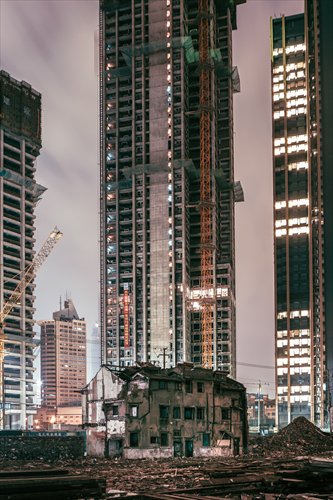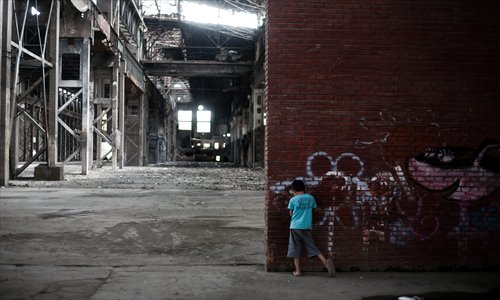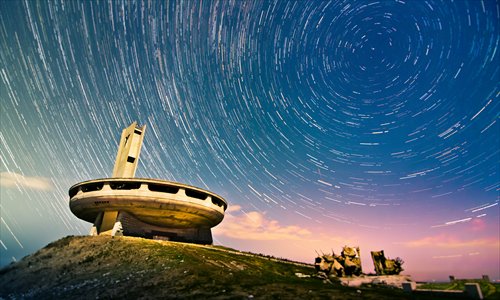Invisible cities
By photographing abandoned ruins, China’s urban explorers hope to retrieve the past

The remains of an old Shikumen house in a recently redeveloped area near the Suzhou River in Shanghai. Photo: Courtesy of Xi Wenlei
Yang Xiao, 30, has been pursued by a patrol helicopter over a 900-year-old castle in Dorset, England; ridden a donkey against an inky night sky in the deserts of Jordan to arrive at the ancient city of Petra; and barely escaped being struck by lightning while atop the 1,441-meter-high Buzludzha Monument in the Central Balkan Mountains of Bulgaria.
Yang is an urban explorer - a pastime that compels her to reconnoiter and photograph man-made sites that have fallen into disuse, and to which access is frequently restricted or prohibited.
"I'm fascinated by our relationship with man-made environments. Everywhere people go, we leave traces and stories behind," said Yang, who works as a designer. Popular sites for urban exploration, also known as urbex or UE, include abandoned factories and hospitals, amusement parks and fall out shelters, catacombs and sewers.
While urban exploration has only recently emerged as a niche hobby in China, the activity has been the subject of mainstream media attention overseas for more than a decade, with popular television series such as Cities of the Underworld (2007) and Off Limits (2001) running for multiple seasons on US cable channels.
"Urban exploration is not as popular here as in countries overseas," said Yang.
"There's no real culture around urban exploration in China, but more and more young people are starting to be interested in it, even if they don't know that much about it."

A child paints on a wall in the abandoned Shougang steel mill in Beijing. Photo: Li Hao/GT
Building connections to the past
Yang's own interest in urban exploration has taken her to more than 20 countries, including Belgium, Russia and Georgia. She has also photographed a planetarium in Beijing after it was abandoned to make way for the 2008 Beijing Olympics.
Unlike some other urban explorers, who take photographs to merely document the sites they visit, Yang said that she tries to take pictures that will recreate a sense of historical connection that binds past and present, through deliberate framing and introducing external sources of lighting.
"I don't want to simply observe or record these places, but to create links between the viewer [in the present] and the [historicity] of the site by manipulating the lighting and [exposure] time," said Yang.
Yang said that her most memorable experience of urban exploration thus far was visiting and photographing the Buzludzha Monument, a gargantuan saucer-like structure built to commemorate the clandestine founding of the Bulgarian Social Democratic Party, which the ruling socialist government at the time saw as their political precursors.
Yang visited the site six times from 2012 to 2013 in order to see it in all weather conditions: in the daytime and at night; during sunrises and sunsets; in mist, blizzard, lightning, sunlight and rain.
She said that she was fascinated by sites that once represented the apogee of a society, but had now been forgotten or fallen into disrepair and neglect. She added that she felt lucky that such places still existed, and that she was able to explore them in relative obscurity.
"I've continued to keep an eye on how these places have changed, either through natural means or by human intervention. I find the whole process to be quite fascinating," said Yang.
Yang said she hopes to publish a photography book of the pictures she's taken of the places she visited, and is already planning her next trip to Eastern Europe.

A figure stands in front of an ethereal light in what was formerly Shangyi catholic school. Photo: Courtesy of Yang Xiao
Telling stories of abandoned places
Xi Wenlei, a 46-year-old photographer in Shanghai, has been exploring the derelict ruins of Shanghai's longtang alleys since 2007, around a decade after many of the traditional Shikumen ("stone gate") houses built in the 1930s started to be demolished.
"The Shikumen houses in the longtang alleys were once the most common domestic living spaces in Shanghai, and also representative of the most modern kind of housing that time," said Xi.
"Now, they are quickly disappearing, so I decided to launch [a] project [to photograph them]."
Xi has shot photographs on more than 20 longtang sites in Shanghai, publishing them online in a collection he calls Ruins of Shanghai.
Xi, who was born in Shanghai and personally witnessed the demise of the Shikumen houses on the bank of the Suzhou River, said the significance of urban exploration photography was simple.
"If you consider the existence of ruins in the history of a city or a country, they are just a flash in the pan, evaporating without being noticed or remembered," said Xi. "But to my mind, documenting and preserving these ruins is the highest calling of photography."
Unlike Yang, Xi said that the significance of his photographs of the Shikumen ruins was their documentary value.
"I like to shoot photographs that show the transformations undergone by the old buildings in Shanghai," said Xi.
"The value of urban exploration photography is determined by the content, and what you choose to convey through the pictures."
Xi recently posted a poem based on his urban exploration of Shanghai's ruins on his website.
"In this moment, the longtong should be flushed with warmth and noise," he wrote. "But all that's left is darkness and deathly stillness."

The Buzludzha Monument in Bulgaria, which was built by the socialist regime in the 1980s. Photo: Courtesy of Yang Xiao
Beijing blues
Zhao Yang, a 28-year-old Beijing-based urban exploration photographer, said he feels a sense of regret that many of the places he has taken pictures of have since been demolished.
"To be honest, I don't think I'll be taking any more pictures in Beijing because there are no longer any sites that interest me," said Zhao, who plans instead to go to the south of China, where he said his curiosity has been piqued by an abandoned textile mill and an abandoned amusement park.
Zhao began an urban exploration photography and video project called "Cooling Plan" in 2008, visiting numerous abandoned sites around the capital, including the disassembled Shougang steel mill and a former Catholic missionary school, Shangyi, built in 1919.
He said that based on his observations, even new buildings in Beijing these days would only last for five years before being demolished. Because of this, said Zhao, buildings did not have time to age or accrue the sort of eroded beauty that only comes with time.
"Demolition and redevelopment of [old buildings] is happening on such a wide scale and with such speed that the potential for urban exploration to grow [in Beijing] is limited," said Zhao.
"Also, a lot of beautiful historical buildings were destroyed during the Cultural Revolution (1966-76) and the current buildings and architecture are very ugly," added Yang.
However, Xi said there were still fertile spaces for urban exploration in China, even with the obstacles and challenges presented by the rapid disappearance of historical buildings.
Beside photography, some urban explorers are leaving their marks through graffiti such as on the walls of abandoned factories in Wuhan, Hubei Province, as reported by the Chutian Metropolis Daily earlier this year.
"For those who are not truly concerned about these ruins, [urban exploration] is just a fad, like a gust of wind," said Xi. "The key [to being a true urban explorer] is to persist."